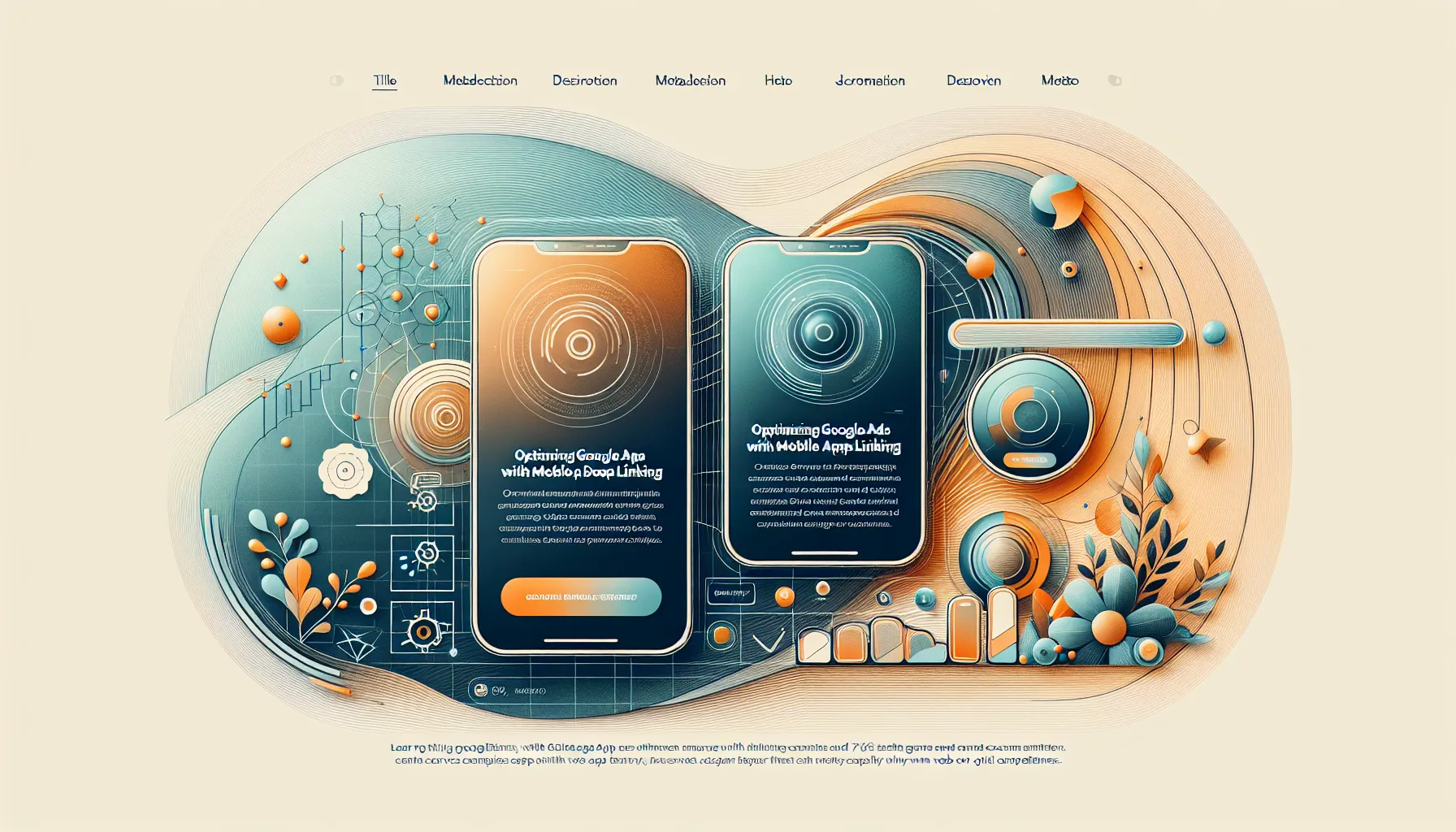Adding a mobile app to your Google Ads strategy can significantly enhance your marketing efforts.
Recent data shows companies with mobile apps grow online sales 7.4% year-over-year compared to just 4.2% for those without apps. 1 This significant difference isn’t coincidental—it’s the result of powerful synergies between mobile apps and digital advertising.
At MetaCTO, we’re helping our clients unlock these advantages by integrating their web-to-mobile app transformations with sophisticated marketing strategies. Here’s how mobile apps are revolutionizing Google Ads performance.
The Power of Deep Linking: Frictionless User Journeys
Deep linking is perhaps the most powerful mobile app marketing capability. It allows you to direct users from ads, emails, or other touchpoints to specific content within your app—not just opening the app’s home screen.
What makes deep linking so effective?
Traditional web ads send users to landing pages where they must navigate to their destination. Even optimized mobile websites introduce friction—slow loading times, login requirements, and clunky navigation can all lead to abandonment.
Deep links, by contrast, create seamless journeys:
- User searches for “blue running shoes size 10”
- Taps your Google search ad
- If they have your app installed, it opens directly to the blue running shoes product page
- Their account is already logged in, and payment methods are saved
- Checkout is just 1-2 taps away
Research shows implementing deep links can increase conversion by over 50% on average by eliminating these friction points. 2
Deep Linking Implementation Types
There are several ways to implement deep linking in your mobile strategy:
Standard Deep Links: Direct users with your app installed to specific in-app content. These work well for users who already have your app.
Deferred Deep Links: Work even when users don’t have your app yet. If they tap an ad and don’t have your app, they’re sent to the app store first, then to the specific content after installation.
Contextual Deep Links: These carry additional parameters that enable personalization. For example, you can track which campaign led to the app install and customize the onboarding experience accordingly.
Firebase Dynamic Links: Google’s solution that works across platforms and devices, providing analytics on how users interact with your links.
App Campaigns: Expanding Your Google Ads Reach
Having a mobile app unlocks an entirely new campaign type in Google Ads: App Campaigns (formerly Universal App Campaigns). These machine learning-powered campaigns promote your app across Google’s entire network, including:
- Google Search
- Google Play Store
- YouTube
- Gmail
- Google Display Network
- Google Discover
App Campaigns optimize automatically to find users most likely to install your app and take specific in-app actions (like purchases). They use Google’s machine learning to show your ads in the places most likely to drive results.
The key advantage is reaching users in contexts where traditional web campaigns can’t appear—like within other apps or in the Google Play Store.
Campaign Types and Objectives
With an app in your portfolio, you gain access to several new campaign objectives:
App Installs Campaigns: Focus on driving app downloads at the lowest possible cost per install (CPI).
App Engagement Campaigns: Target users who already have your app but haven’t been active recently, bringing them back with relevant offers.
In-App Actions Campaigns: Optimize for specific conversions within your app, like purchases or subscriptions.
Value-Based Bidding: Optimize for users likely to spend more in your app over time, maximizing revenue rather than just install volume.
Our clients report that App Campaigns often deliver 20-30% lower cost per acquisition compared to web-based campaigns for similar conversion events. 3
Higher-Value Users and Improved ROAS
One of the most compelling advantages of app-focused marketing is that you’re acquiring higher-value users. Since app users demonstrate higher lifetime value and conversion rates than web-only users, your return on ad spend (ROAS) improves accordingly.
Here’s how the numbers break down:
- Web user average lifetime value: $30
- App user average lifetime value: $85 (2.8× higher) 4
When you factor in higher conversion rates (3-4× better on app vs. web) and higher average order values (30% higher on app), the marketing ROI becomes clear.
This means you might profitably spend more to acquire an app user than a web user because their long-term value justifies the investment. We’ve seen clients increase their allowable cost per acquisition by 2-3× for app campaigns compared to web campaigns and still maintain better overall ROAS.
First-Party Data: Better Targeting and Personalization
Mobile apps provide richer first-party data than websites, enabling more effective targeting and personalization in your Google Ads campaigns.
Because app users typically create accounts and remain logged in, you can track behavior across sessions, purchase history, preferences, and engagement patterns—all tied to a persistent user profile.
This data powers more effective Google Ads campaigns in several ways:
1. Superior Audience Creation
You can create highly specific customer segments based on in-app behavior:
- High-value customers (top 20% by spend)
- Frequent purchasers (4+ orders in 30 days)
- Category enthusiasts (users who browse specific product categories)
- Feature adopters (users who engage with certain app features)
These segments can be used to create Custom Audiences in Google Ads for targeting similar users (lookalike audiences) or for exclusion (e.g., excluding existing loyal customers from acquisition campaigns).
2. More Accurate Conversion Tracking
Apps provide more reliable conversion tracking through Firebase and Google Analytics for Firebase integration. This helps Google’s algorithms better optimize your campaigns toward users likely to convert.
App data enables more precise remarketing:
- Cart abandonment remarketing with exact product images
- Personalized ad creative based on browsing history
- Loyalty tier-specific promotions
- Cross-sell opportunities based on purchase history
Clients using app data for ad personalization see 37% higher click-through rates and 28% higher conversion rates on their remarketing campaigns. 5
Implementation Best Practices
Based on our experience implementing successful app marketing strategies, here are key recommendations:
1. Ensure Proper Tracking Setup
The foundation of effective app marketing is proper measurement:
- Implement Firebase or a similar analytics solution
- Set up conversion events for all key actions
- Configure deep link tracking parameters
- Import app events into Google Ads
- Create a cross-device attribution model
2. Develop a Holistic Customer Journey
Rather than treating web and app as separate channels, design integrated journeys:
- Use web to drive app installs among high-potential customers
- Create app-to-web and web-to-app pathways depending on context
- Ensure consistent messaging and offers across channels
- Develop smart remarketing sequences that use the most appropriate channel
3. Optimize Deep Link Destinations
Not all deep links are created equal:
- Link to specific product pages rather than categories
- For remarketing, link directly to abandoned carts
- Ensure the app state reflects the ad’s promise (e.g., promo code applied)
- Test different in-app landing experiences to maximize conversion
Take advantage of formats designed for app promotion:
- App install ads with feature highlights
- App engagement ads showcasing new functionality
- Demo ads that preview the app experience
- Video ads demonstrating app benefits
5. Budget Strategically Across Channels
Rather than simply splitting budget between web and app campaigns:
- Allocate based on customer lifetime value
- Consider acquisition costs in context of retention rates
- Gradually shift budget as app adoption increases
- Remember that app install campaigns are investments in long-term customers
The Future: App + Web Convergence
Google’s latest analytics platforms emphasize integrating app and web data for a complete view of the customer journey. This trend will continue as companies recognize that customers don’t think in terms of “channels”—they expect seamless experiences regardless of how they interact with your brand.
Forward-thinking companies are already preparing for this future by:
- Implementing Google Analytics 4 with combined app+web properties
- Developing unified customer IDs across platforms
- Creating marketing strategies that leverage the strengths of each channel
- Building attribution models that acknowledge cross-platform customer journeys
Conclusion: The Competitive Advantage
The data is clear: companies that successfully integrate mobile apps with their marketing strategy grow faster than those that don’t. The 7.4% vs. 4.2% year-over-year sales growth advantage represents a massive competitive edge in today’s challenging market.
By combining the higher conversion rates and customer value of mobile apps with the reach and targeting capabilities of Google Ads, mid-market companies can achieve marketing performance previously available only to much larger enterprises.
At MetaCTO, we help our clients navigate this transition—from initial app development through deep link implementation and marketing strategy optimization. The result is not just another sales channel, but a complete transformation of marketing effectiveness.
Ready to transform your Google Ads performance with mobile app integration? Contact our team to discuss how we can help you build and implement a comprehensive web-to-app strategy.
References




